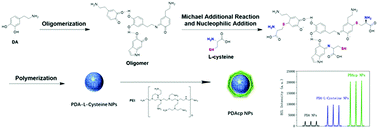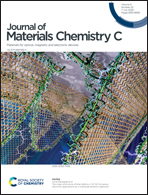A novel l-cysteine regulated polydopamine nanoparticle-based electrochemiluminescence image application†
Abstract
In this work, novel L-cysteine regulated polydopamine nanoparticles (PDAcp NPs) with excellent electrochemiluminescence (ECL) behavior were synthesized. Due to the complex dopamine polymerization and the resulting disordered internal structure, the polydopamine nanoparticles (PDA NPs) suffered from low luminous efficiency and poor optical performance. Therefore, we used L-cysteine to reduce the confusion in the polymerization process and internal structure to improve the luminous property of PDA NPs effectively. On the one hand, the thiol functional group of L-cysteine can react with the dopamine oligomer and undergo the Michael addition reaction. On the other hand, the amino group of the L-cysteine formed a Schiff base with the carbonyl group of the oligomer through nucleophilic addition. The surface of the obtained nanoparticles was further modified by polyethyleneimine (PEI). The prepared PDAcp NPs had 10 times the ECL intensity of the PDA NPs. An inner filter effect-based ECL aptasensing study and image analysis were accomplished for the detection of adenosine triphosphate (ATP). The results showed that the proposed aptamer sensor can determine ATP with a detection limit of 3.79 fmol L−1 and a linear range from 10 fmol L−1 to 100 μmol L−1. The ECL images of the PDAcp NPs were recorded clearly using a smartphone. The visual ECL analysis results indicated that PDAcp NPs have great potential in ECL biosensing and clinical diagnosis.



 Please wait while we load your content...
Please wait while we load your content...